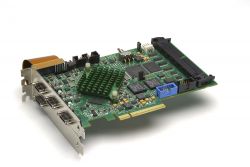BitFlow Announces Five Key Machine Vision Technology Trends for 2017
Identifies Industrial Internet of Things and CoaXPress as trends set to impact machine vision markets
WOBURN, MA, JANUARY 10, 2017 -- BitFlow, Inc., a global leader in machine vision technology, today highlighted five technology trends that will be strategic for the vision industry in 2017. Each has the potential to significantly impact or even disrupt processes, and may poise the need for investment by manufacturers who face the risk of being late to adopt.
"We have identified the top five machine vision trends that integrators and OEMs should factor into their strategic planning for 2017," said Donal Waide, Director of Sales and Marketing for BitFlow. "Vision professionals should look to make deliberate decisions about them during the coming year."
1. The Industrial Internet of Things (IIoT): As the IIoT gains traction, machine vision should see a dramatic boost. IIoT links production technology with information technology, therefore it involves extensive data capture and analytics to continually optimize the operation of factories. Machine vision is one of the most important basic technologies to supply the IIoT with information.
2. CoaXPress (CXP): CoaXPress is an asymmetric high-speed serial communication standard that transmits and receives data over coaxial cables between cameras to computers via a frame grabber. A new generation of lower-priced CXP single-link cameras featuring smaller footprints, lower power requirements and producing less heat are lowering the barrier for integrators to design systems based on the CXP interface. CXP moves at speeds that would humble an Olympic track star; it is almost twice the real world data rate of the USB3 Vision standard and significantly quicker than the latest GigE Vision data rates. BitFlow recently introduced its Aon CXP frame grabbers specifically to address this new low cost/high performance market.
3. Non-industrial Sectors: Lower costs and ongoing improvements in vision components, such as 3-D color cameras and machine learning techniques, will further expand the machine vision sector into non-industrial niche applications, such as "driverless" car systems, IP video surveillance, intelligent traffic systems, logistics, agriculture and guided surgery.
4. Ease of Use: Operators of machine vision systems have expressed a clear preference towards products that contribute to a more user-friendly, intuitive environment on the plant floor. At the same time, vision sensory input is more complex than ever before, making it a huge challenge for device and software designers to simplify their interface. Standardization of products will help users integrate and run vision systems while also providing cost trade-offs for exchangeability of devices. In addition, software designers will be successful as they make strides towards interfaces that walk users through a simple process of setting up applications, locating and inspecting parts, and configuring results with communication to HMIs, PLCs and robotic equipment.
5. Regulation of Pharmaceuticals: Increased regulation globally is forcing the pharmaceutical industry to install machine vision systems to ensure quality, traceability and security at every step of manufacturing ranging from drug synthesis to final packaging. For example, FDA regulations now require a given product to be traceable by serial number to a specific manufacturing facility, batch number and date, providing accountability and ultimately, boosting consumer confidence. The European Union in 2010 required the name of medications to be printed in Braille for blind and partially sighted patients. One key reason for the more stringent regulations is the crisis of counterfeit drugs. The World Health Organization estimates that up to 30% of prescription drugs in developing countries are counterfeit and, in developed countries, counterfeit drugs make up as much as 1% of the market.
According to industry research (1), the global market for machine vision components will grow from $9.0 billion (USD) in 2016 to $12.50 Billion by 2020. This year's predictions came from BitFlow and industry leaders who manufacturer, source and design machine vision systems worldwide. For interviews with BitFlow, or to learn more about their 2017 predictions, contact dan@oconnellpr.com or donal.waide@bitflow.com.
To learn more, please visit www.bitflow.com.
Featured Product

BitFlow Introduces 6th Generation Camera Link Frame Grabber: The Axion
BitFlow has offered a Camera Link frame grabbers for almost 15 years. This latest offering, our 6th generation combines the power of CoaXPress with the requirements of Camera Link 2.0. Enabling a single or two camera system to operate at up to 850 MB/S per camera, the Axion-CL family is the best choice for CL frame grabber. Like the Cyton-CXP frame grabber, the Axion-CL leverages features such as the new StreamSync system, a highly optimized DMA engine, and expanded I/O capabilities that provide unprecedented flexibility in routing. There are two options available; Axion 1xE & Axion 2xE.
The Axion 1xE is compatible with one base, medium, full or 80-bit camera offering PoCL, Power over Camera Link, on both connectors. The Axion 2xE is compatible with two base, medium, full or 80-bit cameras offering PoCL on both connectors for both cameras.
The Axion-CL is a culmination of the continuous improvements and updates BitFlow has made to Camera Link frame grabbers.
